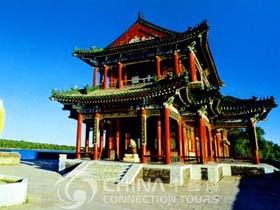
 The Ming tombs are natural sites modified by human influence, carefully chosen according to the principles of geomancy to house numerous buildings of traditional architectural design and decoration. Ming tombs lie in a broad valley to the south of Tianshou (Longevity of Heaven) Mountain in Changping County, about 50 kilometers northwest of Beijing proper. To the southwest of this valley, a branch of the Yanshan Range suddenly to breaks off and forms a natural gateway to the 40-quare-kilometer basin in which the tombs were built. This gateway is "defended" on each side by the Dragon and Tiger hills, which are said to protect this sacred area from winds carrying evil influences. Thirteen out of the 16 Ming emperors are buried in this peaceful valley. The first emperor to be buried here was Yongle who died in 1424. His tomb, Chang Ling, and that of Emperor Zhu Yijun, Ding Ling, who died in 1620, are the only two opened to visitors today.
The Ming tombs are natural sites modified by human influence, carefully chosen according to the principles of geomancy to house numerous buildings of traditional architectural design and decoration. Ming tombs lie in a broad valley to the south of Tianshou (Longevity of Heaven) Mountain in Changping County, about 50 kilometers northwest of Beijing proper. To the southwest of this valley, a branch of the Yanshan Range suddenly to breaks off and forms a natural gateway to the 40-quare-kilometer basin in which the tombs were built. This gateway is "defended" on each side by the Dragon and Tiger hills, which are said to protect this sacred area from winds carrying evil influences. Thirteen out of the 16 Ming emperors are buried in this peaceful valley. The first emperor to be buried here was Yongle who died in 1424. His tomb, Chang Ling, and that of Emperor Zhu Yijun, Ding Ling, who died in 1620, are the only two opened to visitors today.
On November 30, 2000, the Ming Tombs were chosen for the List of the World Cultural Heritage by the United Nations Heritage Commission.

